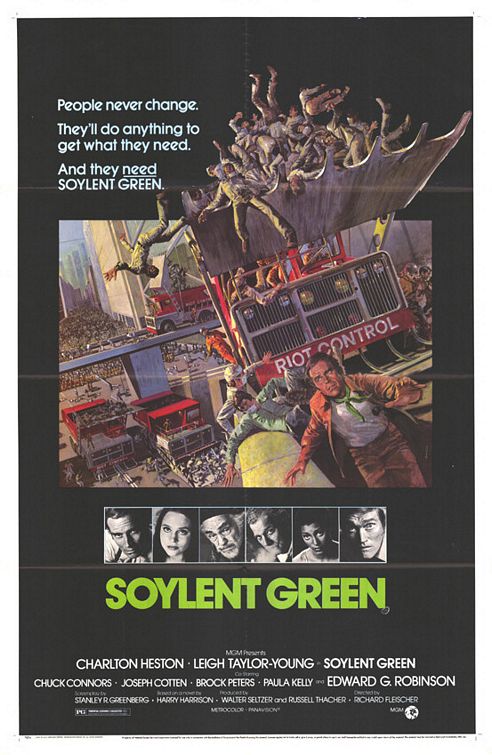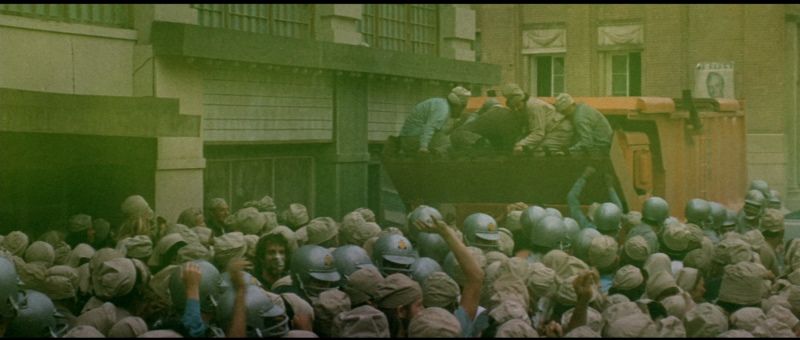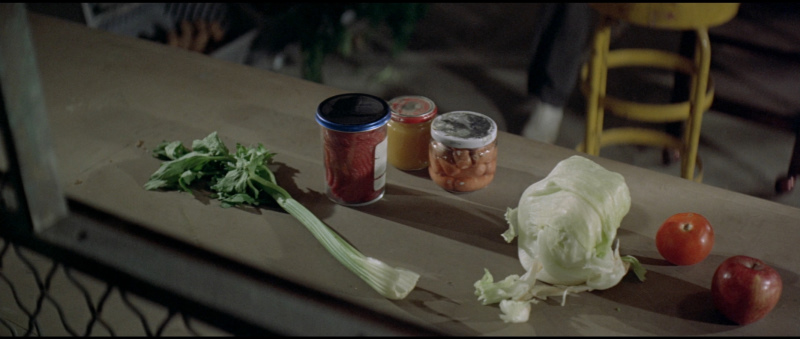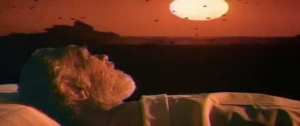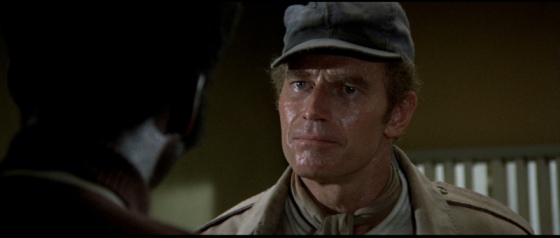In the world of Science Fiction, most readers of novels, viewers of television and movies will always remember a strong ending to a story. The "Twilight Zone" was famous for the twist sucker punch finale of most of the episodes. In the popular culture, when an image or a quote becomes a meme understood by all, it is clear that the work has tapped into something important to the times, politics or people. Charlton Heston is the star of many a movie meme. Moses standing at the Red Sea parting the waves, Ben Hur, either chained to the oars of the Roman Battle cruiser or with rein in hand on a Chariot. His most famous image however is as a dismayed misanthrope pounding sand on a beach in front of the ruins of one of the most recognizable symbols in the world at the end of "Planet of the Apes". Heston has at least one other great moment of Science Fiction history in his vita, the denouncement at the end of the movie "Soylent Green". It is another moment parodied and understood by masses of people, most of whom have never seen the movie. I don't want his refrain to be the only thing people know about the film so this week "Soylent Green" is the movie I want everyone to see.
"Soylent Green" is one of those great 1970s Science Fiction movies that is more about ideas than about special effects. Before the juggernaut that is "Star Wars" came along, most Science Fiction lived in the imagination more than the vision of a story. There were occasional exceptions like "Forbidden Planet" and "2001", but for each of those visually rich movies, there were a dozen other films that made do with small budgets, limited effects and big ideas. Films like "Seconds", "A Boy and His Dog", "Damnation Alley" or "The Omega Man" drew in audience mostly with interesting concepts. Sometimes like with "Planet of the Apes" there was spectacular art direction and set design, but even in that film the visual factor relies on our willingness to accept the story in order to then accept the vision. Most of these films are cautionary tales that try to speak to the worries of the times in which they were made, and "Soylent Green" was one of the finest examples of playing on those contemporary fears.
Stanford Biologist Paul Ehrlich published a book called "The Population Bomb" that predicted a coming world of Malthusian Nightmares. It spawned a whole industry of doomsayers and environmental prophets who suggested that the Earth was over populated and over polluted. The theme of "Soylent Green" is derived from this stream of fearful environmentalism of the early 1970s. This dystopian world is not threatened by nuclear annihilation but starvation and overcrowding. Of course there has also been a substantial amount of global warming to screw up the planet's food supplies as well. Most of this is brilliantly summarized by the title sequence which uses a combination of photos, pacing and music to show us what has happened and is coming.
It was simple and to the point. It was also forty years ago, so perhaps it is a little premature to send us all to a living hell but once the premise is set up the story follows it quite well. William Simonson, a director of the Soylent Corporation is murdered and although there are hundreds of murders a day in the overcrowded world, one detective is unwilling to accept that it is a random burglary. Simonson lives in a luxurious apartment that comes equipped with special security, a bodyguard and living furniture that he can enjoy to his hearts content. It just seems too convenient that the bodyguard was out shopping for groceries with the furniture at the moment this important man was killed in his building. A building where the security system is on the fritz when the apartment is broken into.
Heston plays the determined cop who engages in the kind of casual corruption that seems to be as prevalent in the future as it was in the 1970s with Al Pacino's "Serpico". Detective Thorn is not a bad guy, but he appears to be a vulture at the scene of the crime, scooping up whatever luxury item is likely to go unmissed. Everybody gets a little taste, from his boss to the grunts that remove the body. Thorn takes some vegetables and meat which are incredibly rare commodities in the future. Most people have to survive on manufactured nutrition wafers of different composition, including the recently introduced "Soylent Green". He also acquires a couple of rare technical books that he will not be able to make sense out of but which ought to please his partner Sol Roth, an elderly man who serves as the equivalent of Wikipedia for the future police force.
Most of you know an old timer or two who provides a link to the past. They share stories of the good old days and relate how the world was a better place in their youth (much like your current narrator). For the most part we can dismiss those stories as the nostalgia of an older generation (you know, they walked five miles up hill to school in the snow and then five miles uphill home at the end of the day). This movie posits that the memories of the older generation are not rambling condemnations of change but accurate histories of things that have in fact been lost. The collective of older "books" is known as the Exchange and Sol takes the information from the two Oceanographic Reports that Thorn brought him to the Exchange for evaluation.
The film is a police procedural about a conspiratorial secret which the powers that be are determined to keep a secret. Most of this was pretty standard stuff, but several aspects of the setting make the story so much more compelling. The way in which the citizens have to live, on rationed water, limited food supplies, sleeping on staircases shows how the environment has decayed. The world of the dead man stands in stark contrast to the rest of the population. A rich man with a sex partner who comes with the apartment and access to items that are incredibly out of reach to the rest of the population may seem an unsympathetic victim. We have seen however that there was a sense of guilt in his death, we are aware that there is a conspiracy and we watch Thorn as he picks at each link and follows his instincts to arrive at the truth. In the process the future world is revealed to us bit by bit.
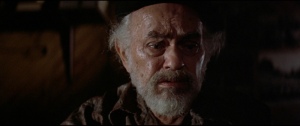 The
term "bromance" has cropped up in the last few years to describe stories
that are about the friendship between two men. Buddy pictures have been
around since the days of silent film, and up through the point this was
released so was Edward G. Robinson. The partnership between Sol and
Thorn is the real relationship in the movie. Heston's character does get
involved with the "furniture" of the dead man, but all of the really
emotional moments of the film involve him and the old man. From some of
the earliest of sound films, Robinson played gangsters, doctors and
bureaucrats.
He was the definitive gangster for the first decade of sound movies as
"Little Cesar". "Soylent Green" gave him the opportunity to go out on a
high note. This was his last film and he played it for all that was on
the page. The scene where Sol prepares the purloined food for a meal for
Heston is a good example. Sol, enjoys it with relish and equally enjoys
watching Thorn, who has never had anything like this enjoy as well.
Robinson waves his plastic utensils as if they were a baton and he was
conducting an orchestra. The crescendo of the piece is the belch Heston
gives at the end of the most satisfying meal of his life. Apparently
this scene was not in the script and was improvised by the two actors
with the prompting of the director. It was a special touch to show their
relationship and the world of the time. At one point Heston's boss
suggests he might need a new "book" but the detective demurs and
continues to have faith in his room mate/partner/father figure.
The
term "bromance" has cropped up in the last few years to describe stories
that are about the friendship between two men. Buddy pictures have been
around since the days of silent film, and up through the point this was
released so was Edward G. Robinson. The partnership between Sol and
Thorn is the real relationship in the movie. Heston's character does get
involved with the "furniture" of the dead man, but all of the really
emotional moments of the film involve him and the old man. From some of
the earliest of sound films, Robinson played gangsters, doctors and
bureaucrats.
He was the definitive gangster for the first decade of sound movies as
"Little Cesar". "Soylent Green" gave him the opportunity to go out on a
high note. This was his last film and he played it for all that was on
the page. The scene where Sol prepares the purloined food for a meal for
Heston is a good example. Sol, enjoys it with relish and equally enjoys
watching Thorn, who has never had anything like this enjoy as well.
Robinson waves his plastic utensils as if they were a baton and he was
conducting an orchestra. The crescendo of the piece is the belch Heston
gives at the end of the most satisfying meal of his life. Apparently
this scene was not in the script and was improvised by the two actors
with the prompting of the director. It was a special touch to show their
relationship and the world of the time. At one point Heston's boss
suggests he might need a new "book" but the detective demurs and
continues to have faith in his room mate/partner/father figure.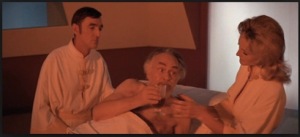 The
other great sequence featuring Robinson, and one that is sadly ironic,
is Sol's decision to end his own story. When advocates of euthanasia
speak of giving patients back their dignity
and providing comfort at the end, they must surely envision a scene
like the one that takes place at the end of the second act. Older people
desiring to die, troop into a modernistic building, fill out a form and
then have some final comforts attended to. Robinson was dying of cancer
when the movie was made and he was almost completely deaf. We would all
hope that his passing would be as beautiful as was depicted here in the
processing center referred to as "home" by those seeking an end to
their time on Earth. Thorn gets the final proof for the motive of the
executive's murder by following his friend through his passage home. As
you watch what is really a simple sequence
of wonderful pastoral scenes and listen to the comforting and thrilling
classical score, you realize how devastating the loss of the world as
it was would be to those able to remember it.
The
other great sequence featuring Robinson, and one that is sadly ironic,
is Sol's decision to end his own story. When advocates of euthanasia
speak of giving patients back their dignity
and providing comfort at the end, they must surely envision a scene
like the one that takes place at the end of the second act. Older people
desiring to die, troop into a modernistic building, fill out a form and
then have some final comforts attended to. Robinson was dying of cancer
when the movie was made and he was almost completely deaf. We would all
hope that his passing would be as beautiful as was depicted here in the
processing center referred to as "home" by those seeking an end to
their time on Earth. Thorn gets the final proof for the motive of the
executive's murder by following his friend through his passage home. As
you watch what is really a simple sequence
of wonderful pastoral scenes and listen to the comforting and thrilling
classical score, you realize how devastating the loss of the world as
it was would be to those able to remember it.The themes and characters have been shared with you a bit, now let's talk about the production. In today's world, this would be a movie crammed with futuristic CGI vistas and sets that were created in a computer. The costumes and equipment would be imagined in fantastic ways to make us feel as if we were in the future. The science fiction films of the seventies were often done on modest budgets and almost always had to make due with creative use of location and existing props. A luxury apartment of the future comes equipped with the latest video game (here it is an early version of Pong). Food riots need to be staged on a New York City back lot, but to make it more futuristic, garbage trucks are modified to remove people rather than trash. The euthanasia center is the googie architectural structure of the L.A. Sports arena and it's futuristic clean style lobby. The focus stays on the ideas rather than the "wow" factor of the look. Even the two books that Thorn confiscates, they are not digital readouts on an i-pad style device, they are simply over-sized volumes given slick covers to convey an advanced type of publishing, nothing fancy but slightly noticeable.
The horrible secret of "Soylent Green" has probably been used as a punchline by thousands of people who never even saw the movie. The fact that the last line has reached into and grabbed the public consciousness is evidence of the effectiveness of the idea behind the film. We are on an environmental brink that may change the relationship of human beings to one another in catastrophic ways. The immorality of a choice might be mitigated by the exigencies of the moment. The movie is an action based detective conspiracy story, but the thought it contains is provocative and the story highlights that issue rather than pushing it aside for action. Just five years after he stands in for the sucker punched audience in front of the Statue of Liberty, Heston finishes another iconic Science fiction thought with his dire warning and outstretched hand. Another entertaining science fiction movie is capped off with a thought that is frightening and thought provoking.
Special Note:
This is the first of my series on Fogs Movie Reviews [Now, Movies I Want Everyone to See] to cover a film I wrote about on my original Movie A Day Project from 2010. If you are interested in a comparison of the posts click here, I did not refer to this earlier post when writing this so you will see some differences in voice and view but probably not too many in attitude or style. Enjoy.
Richard Kirkham is a lifelong movie enthusiast from Southern California. While embracing all genres of film making, he is especially moved to write about and share his memories of movies from his formative years, the glorious 1970s. His personal blog, featuring current film reviews as well as his Summers of the 1970s movie project, can be found at Kirkham A Movie A Day.
